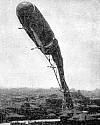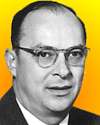 | TODAY IN SCIENCE HISTORY NEWSLETTER - 23 MAY |
| Feature for Today |
 On 23 May 1908, the first U.S. airship disaster struck the airship invented by John A. Morrell. The 450 ft. long dirigible collapsed 300 ft. above the earth, hurling its 16 occupants to the ground, where most were injured, though none died. On 23 May 1908, the first U.S. airship disaster struck the airship invented by John A. Morrell. The 450 ft. long dirigible collapsed 300 ft. above the earth, hurling its 16 occupants to the ground, where most were injured, though none died.There was no radio reporter to lament "Oh, the humanity!" but instead, reading the article Huge Dirigible Balloon Collapses from Popular Mechanics (1908) will give you some insight into the spectacle viewed by a crowd of over 1,000 people. |
| Book of the Day | |
| Quotations for Today | |
 | "The limitations of archaeology are galling. It collects phenomena, but hardly ever can isolate them so as to interpret scientifically; it can frame any number of hypotheses, but rarely, if ever, scientifically prove." |
 | "To invent an airplane is nothing. To build one is something. But to fly is everything." |
 | "Anatomists have ever been engaged in contention. And indeed, if a man has not such a degree of enthusiasm, and love of the art, as will make him impatient of unreasonable opposition and of encroachments upon his discoveries and his reputation, he will hardly become considerable in Anatomy or in any branch of natural knowledge." |
| QUIZ | |
| Before you look at today's web page, see if you can answer some of these questions about the events that happened on this day. Some of the names are very familiar. Others will likely stump you. Tickle your curiosity with these questions, then check your answers on today's web page. | |
| Births | |
 |  John Bardeen, born 23 May 1908, was an American physicist who was cowinner of the Nobel Prize for Physics in both 1956 and 1972. With Leon N. Cooper and John R. Schrieffer he was awarded the 1972 prize for development of the theory of semiconductors, usually called the BCS-theory. He shared the 1956 prize with William B. Shockley and Walter H. Brattain for their joint invention. John Bardeen, born 23 May 1908, was an American physicist who was cowinner of the Nobel Prize for Physics in both 1956 and 1972. With Leon N. Cooper and John R. Schrieffer he was awarded the 1972 prize for development of the theory of semiconductors, usually called the BCS-theory. He shared the 1956 prize with William B. Shockley and Walter H. Brattain for their joint invention. What was this invention? What was this invention? |
 |  On 23 May 1707, Carolus Linnaeus was born. As a Swedish explorer and botanist, he was the first to frame principles for a certain uniform system. On 23 May 1707, Carolus Linnaeus was born. As a Swedish explorer and botanist, he was the first to frame principles for a certain uniform system. What was the system he created? What was the system he created? |
| Deaths | |
| |  Georges Claude (1870-1960) was a French engineer, chemist, and inventor. He invented a light which was the forerunner of the fluorescent light. He first publicly displayed his lamp on 11 Dec 1910 in Paris. He introduced his light to the U.S. at a Packard car dealership in Los Angeles, where it was purchased by Earle C. Anthony for $24,000. Georges Claude (1870-1960) was a French engineer, chemist, and inventor. He invented a light which was the forerunner of the fluorescent light. He first publicly displayed his lamp on 11 Dec 1910 in Paris. He introduced his light to the U.S. at a Packard car dealership in Los Angeles, where it was purchased by Earle C. Anthony for $24,000.  What is the form of lighting he invented? What is the form of lighting he invented? |
 |  William Webster Hansen (1909-1949) was an American physicist who contributed to the development of radar, and is regarded as the founder of microwave technology. He developed the particular kind of vacuum tube essential to generate microwaves. William Webster Hansen (1909-1949) was an American physicist who contributed to the development of radar, and is regarded as the founder of microwave technology. He developed the particular kind of vacuum tube essential to generate microwaves. What is the name of this special vacuum tube? What is the name of this special vacuum tube? |
| Events | |
 On 23 May 1785, a letter from Benjamin Franklin documented his invention of his new glasses. He was writing from France to a friend describing the solution to a problem concerning glasses of the era. The invention had limited acceptance at a time when even ordinary spectacles in the colonies already cost as much as $100 per pair. On 23 May 1785, a letter from Benjamin Franklin documented his invention of his new glasses. He was writing from France to a friend describing the solution to a problem concerning glasses of the era. The invention had limited acceptance at a time when even ordinary spectacles in the colonies already cost as much as $100 per pair. What was Franklin's invention? What was Franklin's invention? | |
| |  On 23 May of a certain year, a first transplant of a human limb took place. A 12-year-old boy's right arm was replaced by Drs. Donald A. Malt and J. McKhann at the Massachusetts General Hospital. On 23 May of a certain year, a first transplant of a human limb took place. A 12-year-old boy's right arm was replaced by Drs. Donald A. Malt and J. McKhann at the Massachusetts General Hospital. In what decade did this limb transplant take place? In what decade did this limb transplant take place? |
| |  On 23 May 1994, an explanation for a "deadly flesh-eating bug" outbreak in England was offered by British doctors. The disease was attributed to a cluster of unusually intense infections by a common bacterium. The people in Gloucestershire had been injured by a toxin that dissolved flesh and fat which came from the excessive bacteria's attack. Normally, the bacteria is associated with a simple infection. On 23 May 1994, an explanation for a "deadly flesh-eating bug" outbreak in England was offered by British doctors. The disease was attributed to a cluster of unusually intense infections by a common bacterium. The people in Gloucestershire had been injured by a toxin that dissolved flesh and fat which came from the excessive bacteria's attack. Normally, the bacteria is associated with a simple infection.What is the normal result of a simple infection by this bacteria? |
| Answers |
When you have your answers ready to all the questions above, you'll find all the information to check them, and more, on the May 23 web page of Today in Science History. Or, try this link first for just the brief answers. Fast answers for the previous newsletter for May 22: Thomas Gold; 9 pounds (4 kg); cytology; television; cathode ray tube; Top Of The Needle restauraunt in the Space Needle in Seattle, Washington; rattlesnake; the decade including the year 1892. |
| Feedback |
 If you enjoy this newsletter, the website, or wish to offer encouragement or ideas, please send feedback by using your mail reader Reply button. If you enjoy this newsletter, the website, or wish to offer encouragement or ideas, please send feedback by using your mail reader Reply button. |
--
If you do not want to receive any more newsletters, this link
To update your preferences and to unsubscribe visit this link
If you do not want to receive any more newsletters, this link
To update your preferences and to unsubscribe visit this link
! !


Δεν υπάρχουν σχόλια:
Δημοσίευση σχολίου